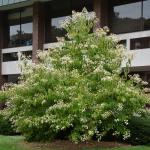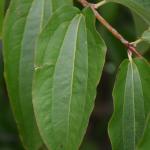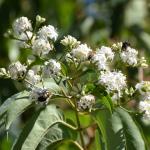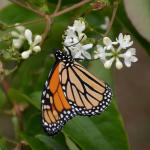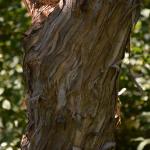A monthly e-newsletter from UMass Extension for landscapers, arborists, and other Green Industry professionals.
To read individual sections of the message, click on the section headings below to expand the content:
Hot Topics
Planting for Resilience: Selecting Urban Trees in Massachusetts
A new street tree selection guide, Planting for Resilience: Selecting Urban Trees in Massachusetts, has been produced by the Massachusetts Department of Environmental Conservation and the Center for Agriculture Food and the Environment at the University of Massachusetts Amherst. The guide was authored by graduate researcher Ashley M. McElhinney and Extension Associate Professor of Urban and Community Forestry, Dr. Richard W. Harper. It is designed to function as a key resource for anyone interested in selecting and planting a tree in the Commonwealth of Massachusetts, including tree wardens, urban foresters, professional arborists, volunteers that work with urban trees, and private residents.
The guide aims to provide readers with the information necessary to more confidently choose which tree species is best for their planting site, employing the “right tree, right place” approach. Proactive planning is a critical strategy to creating and maintaining a healthy, diverse urban forest that ranges from the downtown urban core, to parks and greenways, to private properties. Trees growing in urban areas are becoming increasingly important in maintaining and protecting human and environmental health in the face of urbanization and global climate change.
This guide outlines the characteristics and attributes of each of its tree species, detailing ornamental traits and site preferences. It also includes observations regarding tolerance to adverse conditions often found in urban environments, and information relative to climate change adaptability.
Profiles for nearly 80 recommended tree species are included, ranging from native trees found commonly grown and planted in Massachusetts, to non-native trees adept for tough urban environments. A critical objective of this guide is to encourage diversity among urban trees at the time of selection and planting.
A two-part resource featuring both a video tutorial discussion of the guide and a free downloadable version of the guide (pdf), has also been made available on the ‘Lecture’ section at www.urbanforestrytoday.org. Certified arborists who view the tutorial and download the guide may obtain continuing education credits (1.0 ISA CEU’s & 0.5 MCA credits).
Ashley M. McElhinney, M.S., is a graduate of the Department of Environmental Conservation, University of Massachusetts, Amherst, MA.
Richard W. Harper, Ph.D., is the Extension Associate Professor of Urban & Community Forestry, Department of Environmental Conservation, University of Massachusetts, Amherst, MA.
The authors gratefully acknowledge the support and expertise of Gwendolyn Stoll and Professors Bethany Bradley, Ph.D., and Mandy Bayer, Ph.D.
This work was supported by the USDA National Institute of Food and Agriculture – McIntire Stennis Project # 34, Accession #1014171. This reference was funded in part by the USDA Forest Service through the Massachusetts Department of Conservation and Recreation Urban & Community Forestry Program. The University of Massachusetts is an equal opportunity provider.
Questions & Answers
Q: I’ve been hearing more and more lately that perennials and leaves should be left in place through the winter and cleaned up in the spring. Clients are beginning to ask about this approach but are concerned about departing from traditional practices. Is this a sound practice? What are the implications that we and our clients should considered? What is the benefit of leaving plants in place? Is there a useful middle ground between cutting everything back and leaving everything intact?
A: Conventional landscape practices recommend cutting back perennials and completely cleaning up leaves from lawns and garden borders before winter sets in. Hard habits to break, but recent practices suggest that some or all of these materials should be left in place for the benefit of wildlife, including pollinators. It’s likely that for most clients a transition from a conventional cleanup to a more sustainable approach will be a gradual process; after all, we’ve trained them to appreciate the beauty of a tidy landscape at the end of the growing season; touted the benefits of a clean slate each fall; and instilled a sense of satisfaction in having concluded the season cleanly, erasing disappointments from the growing season just past. But there is, in a thoughtfully edited garden not wiped clean of the previous season’s growth, a unique beauty combined with the satisfaction of contributing to a healthy ecosystem. A winter garden, punctuated with the stems and seed heads of perennials, and the fruits, barks, and berries of trees and shrubs standing in contrast to stark white snow, provides a beauty all its own. The benefit of drawing in birds over the winter and supporting the insects that will in turn enliven the garden and surrounding ecosystem in the seasons ahead should help to tip the scale, for you and your clients, towards a more moderate approach to fall clean up.
Here are some things that you should consider:
- Spring is often a time to launch new landscape projects, clean up winter storm damage, renovate borders and plant seasonal displays. If adding garden cleanup causes a log-jam of work to be done, try making the transition over time. Execute some cleanup in the fall, focusing on plants that provide neither beauty nor value for wildlife. Leave as much as is practical to benefit other organisms and provide winter beauty. Complete the cleanup in spring.
- Consider your soils - poorly drained or excessively moist soils are often difficult to work in spring when foot traffic and equipment increases compaction and damages the soil structure. If this description fits all or part of the landscape you are tending, try to cleanup as much as possible in the fall when soils tend to be drier, or before the ground thaws in the spring.
- If you have issues with mice and/or voles. Cut masses of foliage back and leave no hiding places for these critters. Voles are mostly subterranean and love to hide in leaf litter. They will decimate the roots of plants by feeding on them, and will also strip the bark above ground. If they are a known problem, cut foliage back thoroughly and clear fallen leaves from beds and borders.
What plants should be left intact and which should definitely be cut?
- Remove all annuals as they begin to fade at the end of the season. Pull them from the ground, shake off excess soil and dispose of them in the compost unless diseased. Diseased plants go into trash or are removed far from the garden.
- Clean up any diseased or insect infested plant material and dispose of it out of the garden, away from compost. Most folks prefer to dispose of diseased foliage in the trash to ensure that the offending pathogens are not reintroduced into the garden. Generally, peonies, bearded iris, summer phlox, beebalm, and any other perennials that are susceptible to fungal diseases. Anything that you know had an insect problem – aphids for example - should be cut back and removed.
- Cut back those plants that become more difficult to clean up after the winter – hosta, for example, which turn into a pile of mush - or daylilies, which are more easily cut in the fall when foliage is crisp and firm, rather than stringy pulp in the spring. These perennials provide very little in the way of food and cover for birds, etc. and won’t be missed this winter.
- Cut anything you don’t want to seed in – maiden grass (Miscanthus sinensis) or purple angelica (Angelica gigas) for example, which have the potential to seed in heavily or in unwanted locations. With Miscanthus, you can simply cut the flower stalks off before seeds ripen and leave the mass of slender foliage for beautiful winter effect. Try to cut the foliage back in late February or early March before they break free and lodge in other plants.
- Clean up areas that are planted with early-emerging bulbs and ephemerals like snowdrops (Galanthus sp.), winter aconites (Eranthis hyemalis), Narcissus, Scilla, Chionodoxa, Bearded Iris (Iris germanica), Epimedium, Adonis, and Virginia bluebells (Mertensia virginica) so that these plants can emerge unimpeded.
- A few tender plants appreciate having stems left intact to gather leaves and provide a bit of insulation for the winter. Tender shrubs which are treated like perennials, like blue-mist shrub (Caryopteris incana) and Beautyberry (Callicarpa sp.), may die back to the snow line, or not, depending on the severity of the winter. Leave them intact for the fall and cut them to a living point in spring if necessary.
- Some of the plants that add richness and beauty or are particularly useful to insects and other wildlife are black-eyed Susan’s (Rudbeckia sp.), gayfeather (Liatris sp), Sedum, Astilbe, coneflowers (Echinacea sp.), ornamental grasses like feather reed grass (Calamgrostis ‘Karl Foerster’), fountain grass (Pennisetum alopecuroides ‘Hameln’), maiden grass (Miscanthis sinensis ‘Gracillimus’), little bluestem (Schizachyrium scoparium), baneberry (Actaea rubra and A. pachypoda), and culver’s root (Veronicastrum virginicum). Some of these plants, laden with seeds, are like little above ground birdfeeders held on slender pedestals above the snow, when all else is covered. Others provide the perfect stem for insect-like preying-mantis, spiders, and bees to lay their eggs in or on, or for moth and butterflies to attach their cocoons to.
- Certain areas of each yard warrant more clean up than others. Beds at the foundation, or along an entry path where snow will accumulate, along driveways or where early emerging bulbs and wildflowers are planted. Consider creating areas where leaving plants and foliage up contributes both to the beauty of your winter scene and the ecology around us – the backs of borders, edges of lawns, meadows and fields, for example.
Q. What about leaves? Shouldn’t they be cleaned up thoroughly?
A. This, too, this depends on where you and your clients are in this spectrum of neat to relaxed, meticulous to more concerned about wildlife, and it depends on what your tree canopy is like.
As with perennials, clean up and remove anything that’s diseased to help break the disease life cycle – get rid of the foliage of lilacs that had powdery mildew, maples that had tar leaf spot, dogwoods that had powdery mildew, and apple or crabapple foliage that was plagued with cedar apple rust or apple scab.
If you have lots of birch, Japanese maples, and similarly small foliaged trees and the leaf litter is not dense and packed down, as it often is with oaks, Norway maples, magnolias, etc., and you don’t have a vole problem, you can leave the foliage in place and do some clean up in spring.
Q: Why leave them in place?
A: Many beneficial insects, moths and butterflies lay their eggs on these leaves and count on having their offspring hatch out next on their host plant. If you scoop up and bag these leaves, you’re killing off these beneficial eggs, larvae, and caterpillars. The same is true if you’re mulching all those leaves to turn them back into organic material to feed your lawn; lots of those critters don’t come though that process alive. If possible, try to find some middle ground where some leaves are left intact near the host plant – perhaps on the perimeter of lawns or borders.
Finding the middle ground and transitioning to more sustainable garden management may require a bit of time as we and our clients adjust to a new look and new schedule of maintenance. The sooner we make the shift, the more vibrant and healthy our landscapes and surrounding habitats will be.
Joann Vieira, Director of Horticulture, The Trustees of Reservations
Trouble Maker of the Month
Coral-Spot Nectria Canker
Coral-Spot Nectria Canker is caused by the fungal pathogen Nectria cinnabarina. This species has a very broad host range among deciduous trees and shrubs present in landscape settings. Common hosts include maple, beech, hornbeam, honeylocust, elm, hydrangea, apple, cherry, oak and pear, among many others. Coral-spot canker derives its name from the conspicuous pinkish- to orange-colored pads of fungal tissue that rupture through the bark on infected stems and branches. These pads swell to release large volumes of spores that are splashed or blown onto adjacent branches, where new infection centers are initiated. Cankering pathogens like Nectria can girdle stems and branches, causing a progressively worsening canopy dieback. They are often associated with stressed and weakened trees and shrubs. Most invade wounds created by pruning, insect feeding, ice/wind storms, etc. Once present in the canopy, it’s imperative to prune infected branches and remove them from the site. Prune at least 6–12″ away from symptomatic tissue to ensure the pathogen has been fully excised. Symptoms may include cracking, splitting and sloughing bark, sunken depressions on branches, dark-colored staining of the bark, desiccation and wilting of the foliage and general dieback. Once Nectria has been identified and infected parts are pruned, regular scouting and additional pruning is often required to fully remove the pathogen from the infected tree or shrub. Locally-systemic fungicides may be of assistance depending on the size and condition of the tree or shrub. However, in many cases, fungicides fail to reach the pathogen because it may be present in branches or stems that are not symptomatic at the time of treatment.
For more information see the Coral-Spot Nectria Canker Fact Sheet.
Nicholas Brazee, UMass Extension Plant Pathologist
Plant of the Month
Heptacodium miconiodes, Seven-son Flower
Fall flowering shrubs and trees are hard to come by in the Northeast, making Heptacodium miconiodes a welcome sight in the landscape. This multi-season beauty’s peak time of appeal is later summer to early fall, adding diversity to the landscape and serving as a great late-season nectar source for butterflies and other pollinators. This unique plant is somewhat new in commerce in the United States. It was first brought to the US from China in the early 1900s but was somewhat forgotten until the 1980s when it was reintroduced.
The genus name, Heptacodium, comes from the translation of the Chinese name for the plant and refers to the seven-part flower clusters. Flowers emerge in late summer to early fall (usually September). The white, fragrant flowers occur in terminal clusters and are very showy. Flower clusters give way to small fruits surrounded by persistent sepals. The sepals change from green to pinkish-red and are equally showy to the flowers, adding additional ornamental interest late into the fall.
Leaves are a medium, glossy green ovate with a pointed tip. Leaves are attractive but don’t offer fall color. The bark exfoliates in thin strips, resembling that of crapemyrtle, and provides winter interest. Plants can be trained as a large shrub or small tree with an upright, loose habit growing 15-20’ tall and about half as wide.
Seven-son flower is best planted in well-drained soil in full sun but can tolerate dappled shade. It is adaptable to many soils and easily transplants from a container. Heptacodium miconiodes does not have serious insect or disease problems, but canker-related dieback has been reported. This unique plant can be used as a specimen, accent plant, or as part of the shrub border or woodland garden. Although somewhat difficult to find, seven-son flower can bring some unexpected ornamental features to the fall landscape.
Cultivars:
‘Temple of Bloom’ – 6-10’, sepals have a deeper red color, early bloom time (for extended bloom time in colder areas)
Upcoming Events
Invasive Insect Certification Program
October 17, 31 & November 14
This three-day program looks at the characteristics of invasive insects, the impacts and costs they have regionally and nationwide, and highlights the biology, ecology, and identification of some of the most destructive insects. Participants may receive a certificate in INVASIVE INSECT MANAGEMENT upon the successful completion of all three sections of this series and acheiving a passing score on associated online quizzes following each class. Participants not interested in a certificate may also attend all three days, or individually, without taking the associated quiz. Attendees are encouraged to take all three sessions in one season to get the most out of the information. The three sessions are Part 1: The Impacts and Costs of Invasive Insects (4 pesticide contact hours for categories 35, 36 and Applicators License), Part 2: Invasive Forest and Agricultural Insects in Massachusetts: Current and Future (3 pesticide contact hours for categories 35, 36 and Applicators License), and Part 3: Management of Invasive Forest and Landscape Insect Pests (3 pesticide contact hours for categories 35, 36 and Applicators License).
Association credits: ISA, SAF, MCA, MCLP, and MCH credits available.
Registration and Additional Information.
Other Upcoming Events:
- 10/9: Tick Webinar - 2019 Tick Updates from the UMass Laboratory of Medical Zoology
- 10/17, 10/31 & 11/14 - Invasive Insect Certification series
- 11/21 - Fall Wrap-up
For more information and registration for any of these events, go to the UMass Extension Landscape, Nursery, and Urban Forestry Program Upcoming Events Page.
Additional Resources
For detailed reports on growing conditions and pest activity – Check out the Landscape Message
For commercial growers of greenhouse crops and flowers - Check out the New England Greenhouse Update website
For professional turf managers - Check out Turf Management Updates
For home gardeners and garden retailers - Check out home lawn and garden resources. UMass Extension also has a Twitter feed that provides timely, daily gardening tips, sunrise and sunset times to home gardeners, see https://twitter.com/UMassGardenClip
Diagnostic Services
A UMass Laboratory Diagnoses Landscape and Turf Problems - The UMass Extension Plant Diagnostic Lab is available to serve commercial landscape contractors, turf managers, arborists, nurseries and other green industry professionals. It provides woody plant and turf disease analysis, woody plant and turf insect identification, turfgrass identification, weed identification, and offers a report of pest management strategies that are research based, economically sound and environmentally appropriate for the situation. Accurate diagnosis for a turf or landscape problem can often eliminate or reduce the need for pesticide use. For sampling procedures, detailed submission instructions and a list of fees, see Plant Diagnostics Laboratory
Soil and Plant Nutrient Testing - The University of Massachusetts Soil and Plant Nutrient Testing Laboratory is located on the campus of The University of Massachusetts at Amherst. Testing services are available to all. The function of the Soil and Plant Nutrient Testing Laboratory is to provide test results and recommendations that lead to the wise and economical use of soils and soil amendments. For complete information, visit the UMass Soil and Plant Nutrient Testing Laboratory web site. Alternatively, call the lab at (413) 545-2311.
